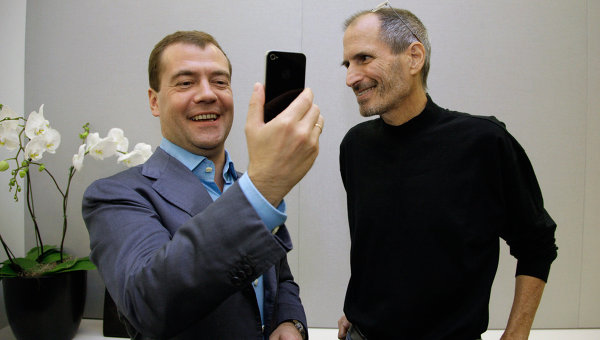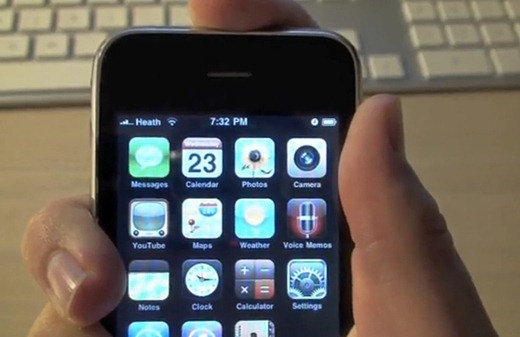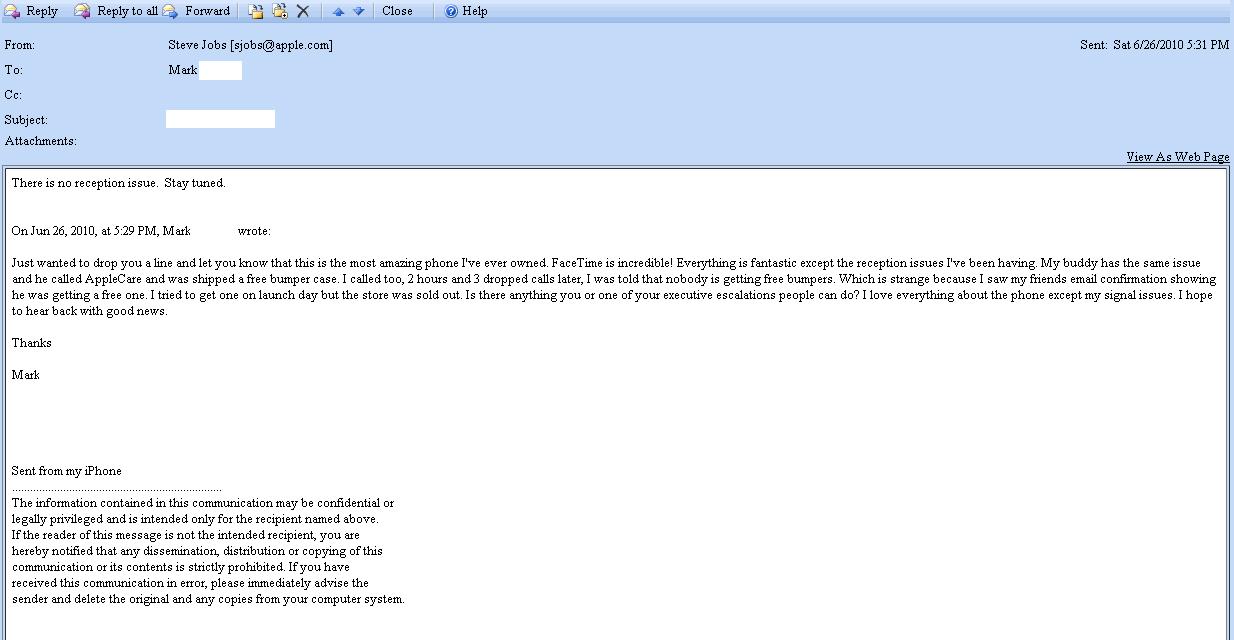^^^ Steve the magician lol. That is unfortunately funny.
------
Despite well publicized reports of iPhone 4 reception issues, one analyst said he sees Apple, in the "worst case," discounting or giving away protective bumpers with little financial impact on the company.
Analyst Shaw Wu with Kaufman Bros. issued a note to investors Friday in which he discounted the antenna concerns as "overdone." Since the iPhone 4 launched, discussion of dropped calls from holding the device in one's left hand has grown, and Apple even publicly commented on the issue.
"We don't think the antenna issue is that big of a deal where it would warrant a product recall," Wu wrote. "The reason is that most users have a case anyway to protect their iPhone and to customize to their personal preferences. In our view, in the worst case, Apple provides a discount on the $29 iPhone 4 bumper case or includes one for
free with an iPhone 4 purchase. Either way, we do not think this would have a material impact impact on our forecasts."
Apple, in a statement, said that gripping any mobile phone will affect its antenna performance. The company suggested that users avoid gripping the device in the lower left corner.
But the problem is also alleviated by using a case, which prevents the metal band around the perimeter of the device from making contact with the user's skin. The issue can reportedly be avoided when using the official "bumper" case sold by Apple.
Wu is particularly bullish on Apple's launch of the iPhone 4, predicting that the company sold between 1.5 million and 2 million units. On the high end, that would double the debut of the iPhone 3GS a year ago.
Wu's prediction of 2 million is higher than other analysts who believe Apple will sell closer to 1.5 million of the iPhone 4 at launch. Last week, after the first day of preorders, Apple revealed that more than 600,000 devices had been sold.
------
Reception issues observed by new iPhone 4 owners, derided as the "Death Grip" by bloggers, appears to actually be a software issue that an iOS update is expected to resolve early next week.
Identifying the problem
Clear observations of mobile signal strength and how they are affected by the placement of users' hands are difficult to perform in part because there are multiple factors involved in receiving a mobile radio link, including outside interference and the conductivity or mass of different people's hands.
Additionally, cellphones in general (and in particular the iPhone) have always only presented a very rough approximation of signal strength in the signal bar display, averaged over time. It appears that iOS 4, more so than previous iPhone software, presents a less accurate signal meter, showing less signal at times than an iPhone 3GS while still being able to achieve the same or better call quality.
This has led some to jump to the conclusion that the reception problems noted by some iPhone 4 users are the sign of a hardware design flaw related to its stainless steel band antenna design. Apple's chief executive Steve Jobs stoked a whiplash of blogger frenzy when he reportedly responded that users "were holding it the wrong way," blocking the signal with their hands.
A variety of people have demonstrated identical problems with other phones, from the Android based Nexus One to the iPhone 3GS. Yesterday, my wry tweet, "Blocking iPhone 4 antenna kills reception. Blocking mic kills audio, and covering the screen makes it impossible to see Retina Display" made it to the front page of Twitter and was retweeted more than a hundred times by people following the hullabaloo.
However, the fact that problems observed in the iPhone 3GS are much more pronounced when the device is upgraded to iOS 4 indicate that there is also a software issue involved in the matter. iPhone 4 users can't downgrade to earlier versions of the core software, making it impossible to compare its relative performance.
Software fix in the works
Readers report that Apple's tech support forums originally confirmed that a iOS 4.0.1 software fix addressing the issue would ship early next week (as early as Monday), before the comments were subsequently taken down along with all the other related discussion about the matter.
The fix is expected to address a issue in iOS 4 related to radio frequency calibration of the baseband. Readers who saw the original forum discussions say that the issue is believed to occur when switching frequencies; because the lag is allegedly not calibrated correctly, it results in the device reporting "no service" rather than switching to the frequency with the best signal to noise ratio.
iOS 4 introduced some enhancements to how the baseband selects which frequencies to use, so it makes sense that the error may have crept into those changes. Additionally, this explains why iOS 4 has also caused similar problems for iPhone 3GS users.
Additional readers have shared other related experiences that also corroborate the idea that the issue is related to iOS 4's software control of the baseband, including the fact that the issue seems easily reproducible when connecting to a WWAN 3G network but does not appear when connecting to a Microcell 3G. If the problem were simply hardware related issues of the antenna design, it should only affect iPhone 4 units with that new design and should occur at all times, regardless of the tower type. That is not being observed.
Talk to the hand
The core software problem is likely augmented by hand placement, as Jobs noted in pointing out that holding the new phone (or any mobile device) in such a way that attenuates the signal should simply be avoided.
Yesterday, antenna design expert Spencer Webb posted his early appraisal of the situation, noting that the FCC mandates that cell phone antennas need to be positioned as far away from the user's head as possible, effectively forcing antenna placement in the bottom of the phone, where it is most likely to be covered by the user's hand.
Webb also noted that neither the regulatory tests performed by the FCC during its approval process, nor the antenna efficiency tests performed by the carrier (AT&T) during its own device requirements testing take into account how a user's hand might play into the antenna design and the test results.
The bottom-mounted antenna design "evolved to meet [FCC] requirements," Webb explained. "And efficient transmission and reception while being held by a human hand are simply not design requirements!"
Webb points out that Bluetooth headsets also suffer from attenuation when the phone is positioned in such a way that the user's body absorbs too much of the signal. He assumed that the iPhone 4 design, which "moved the antenna action from the back of the phone to the sides," will likely only improve things when the phone is "suspended magically in air," but may actually make things worse when the phone is placed in the user's pocket.
At the same time, Webb says he voted with his dollars to buy the new iPhone 4 anyway, adding, "sometimes an antenna that's not great, but good enough, is good enough."
------
The DevTeam and others have been checking through the iPhone 4, and have noticed the baseband runs a completely different OS than on previous models. The iPhone 3G and 3G[S] both ran Nucleus OS on the PMB8878 baseband CPU (aka XGold 608), where the iPhone 2G ran the PMB8876 (aka S-Gold 2). iPhone 4 uses the PMB9800, or X-Gold 618 – running a separate OS – ThreadX, an RTOS by ExpressLogic.
What’s all that mean to you?
Basically, once the iPhone 4 is jailbroken, the unlock won’t be an immediate release. iOS4 is already un-lockable using ultrasn0w 0.93 on the earlier iPhone models, but the payload will need to be rewritten for iPhone 4 once an exploit is discovered in the new baseband OS. Hopefully the port itself will have introduced some. No way to estimate any sort of timeline until further investigating is done
------
MacWorld has done an analysis of the iPhone 4's camera comparing it to popular smart phones, entry level digital cameras, and the Flip.
The iPhone 4's 5MP camera performed very well in their tests beating out all the other smartphones in photo quality.
Video quality was also very high with only the Flip performing better due to its far superior audio.
Apple said the quality of the camera parts is more important to capturing good photos than a high megapixel count. Our lab's test results support that theory, showing that a 5-megapixel camera can shoot higher quality images than an 8-megapixel camera.
For casual photographers who mostly post their images online, the iPhone 4’s bump in image quality might be enough to make them think twice before packing an additional gadget. Quality wise, it still isn’t quite on par with entry-level point-and-shoot cameras, but the iPhone's convenience (it’s already in your pocket), low-light capabilities, and access to a large amount of editing and sharing apps, could mean trouble for the inexpensive digital camera market.
You can find some sample pictures and rankings below. Hit the
link for their full analysis.


------
A source tells HardMac that Apple is planning on a completely new branding for the Mac OS X software, similarly to what has been done with the iPhone. Current rumors include using iOS as a default branding of Apple OS, resulting in iOS desktop, iOS server and iOS mobile versions. The source also notes that this decision is not final, but it is supported by 'high management'
One of our sources told us that Apple might be deciding about a totally new branding for its OS, similarly to what has been done with the iPhone. They are currently thinking of using iOS as the default naming/branding of Apple OS. We would then have iOS desktop, iOS server and iOS mobile. The final decision is not taken yet, however, the proposal seems to be well supported by the high management, it would give a better exposure and unity to Apple OS platforms while making communication easier.
------
We know that prototype iPhone 4 units were disguised to look like older generation units using some clever cases. Now the NYT is speculating that this clever iPhone 4 testing disguise may have actually prevented Apple from noticing the odd antenna performance when the phone is held directly.
The theory sounds reasonable enough because cases like the one used prevent individuals from actually coming into direct contact with the iPhone 4 antenna points and in turn would prevent some of the recently reported reception issues.















